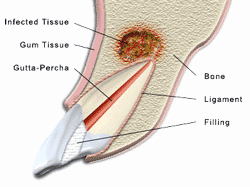Your teeth are held in place by roots that extend into your jawbone. Front teeth usually have one root. Other teeth, such as your premolars and molars, have two or more roots. The tip or end of each root is called the apex. Nerves and blood vessels enter the tooth through the apex. They travel through a canal inside the root, and into the pulp chamber. This chamber is inside the crown (the part of the tooth you can see in the mouth).
During Root canal therapy (Endodontic treatment), the canals are cleaned. Inflamed or infected tissue is removed. An apicoectomy may be needed when an infection develops or won’t go away after root canal treatment or retreatment.
Root canals systems are very complex, with many small branches off the main canal. Sometimes, even after Root canal therapy (Endodontic treatment), infected debris can remain in these branches. This can possibly prevent healing or cause re-infection later. In an apicoectomy, the root tip, or apex, is removed along with the infected tissue. A filling is then placed to seal the end of the root.
An apicoectomy is sometimes called endodontic microsurgery because it is often done using an operating microscope.
If a root canal procedure has been done in the past and it becomes infected again, it’s often because of a problem near the apex of the root. In many cases, a second Root canal therapy (Endodontic treatment) is considered before an apicoectomy. With advances in technology, endodontists often can detect other canals that were not adequately treated. In this case, they may be able to clear up the infection by doing a second root canal procedure. This will avoid the need for an apicoectomy.
Our endodontists can do an apicoectomy to fix the problem so the tooth doesn’t need to be extracted. An apicoectomy is done only after a tooth has had at least one root canal procedure and retreatment has not been successful or is not possible. For example, retreatment is often not a good option when a tooth has a crown or is part of a bridge. Retreatment of the root canal would require cutting through the crown or bridge. That might destroy or weaken the crown or bridge. An apicoectomy is often considered in a situation like this.
An apicoectomy is not the same as a root resection. In a root resection, an entire root is removed, rather than just the tip.
 Preparation
Preparation
Before the procedure, you will have a consultation with one of our dentists. We will also review your medical history. Depending on other existing medical conditions, we may consult with your physician before the procedure.
Before the surgery, you may be given an antimicrobial mouth rinse, a medicine to reduce inflammation, and/or antibiotics.
The endodontist will incise and lift the gum away from the tooth to gain access to the root. The infected tissue will be removed along with the last few millimeters of the root tip. The endodontist will use a dye to highlight cracks and breaks in the tooth. If the tooth has large cracks or breaks, it may have to be extracted. In this case, the apicoectomy will not continue.
To complete the apicoectomy, the endodontist will clean and seal the end of the tooth’s canal. The cleaning usually is done under a special microscope using ultrasonic instruments. The light and magnification allow the endodontist to see the area clearly. This increases the chance that the procedure will succeed. The endodontist then will take an X-ray of the area before stitching the tissue back in place.
Most apicoectomies take 30 to 60 minutes. The length will depend on the location of the tooth and the complexity of the root structure. Procedures on front teeth are generally the shortest. Those on lower molars generally take the longest.
Follow-up
We will send you home with written after-care instructions. Your endodontist will tell you which medicines to take and what you can eat or drink. You should apply ice to the area for 10 to 12 hours after the surgery, and rest during that time.
The area may bruise and swell. It may be more swollen the second day after the procedure than the first day. Any pain usually can be controlled with over-the-counter nonsteroidal anti-inflammatory drugs (NSAIDs), such as ibuprofen (Advil, Motrin and others). In some cases, you may be given a prescription pain medicine.
To allow for healing, you should avoid brushing the area or rinsing vigorously until your follow-up appointment. Also, don’t smoke or eat crunchy or hard foods. Do not lift your lip to examine the area. This can loosen the stitches and disrupt formation of the blood clot that is needed for healing.
You may have some numbness in the area for days or weeks after the surgery. Tell your endodontist about any numbness. The numbness usually goes away with time.
Your stitches will be removed approximately 7 days after the procedure. All soreness and swelling are usually gone within 14 days.
Even though an apicoectomy is considered surgery, many people say that recovering from it is easier than recovering from the original Root canal therapy (Endodontic treatment).
Risks
The endodontist will review the risks of the procedure at the consultation visit. The main risk is that the surgery may not work and the tooth may need to be extracted.
Depending on where the tooth is located, there may be other risks. If the tooth is in the back of your upper jaw, the infection can involve your sinuses. Your endodontist may suggest antibiotics and decongestants.
The roots of the back teeth in the lower jaw are close to some major nerves. Surgery on one of these teeth carries a slight risk of nerve damage. The chances of anything happening are extremely small; however, your endodontist will use your X-rays to see how close the roots are to the nerves.
An apicoectomy is usually a permanent solution. It should last for the life of the tooth.

